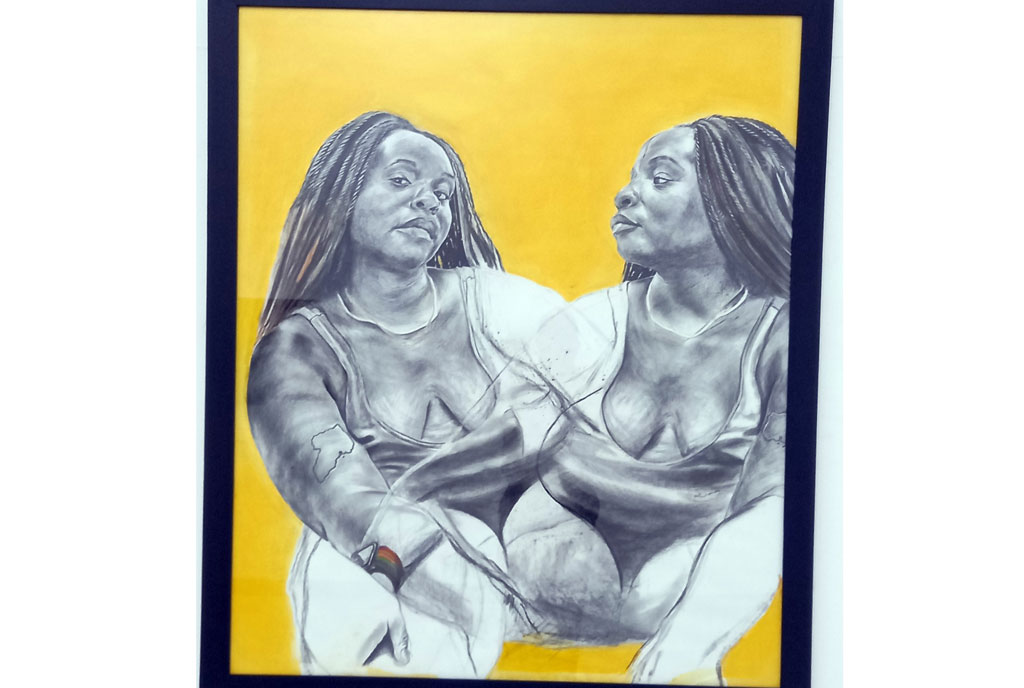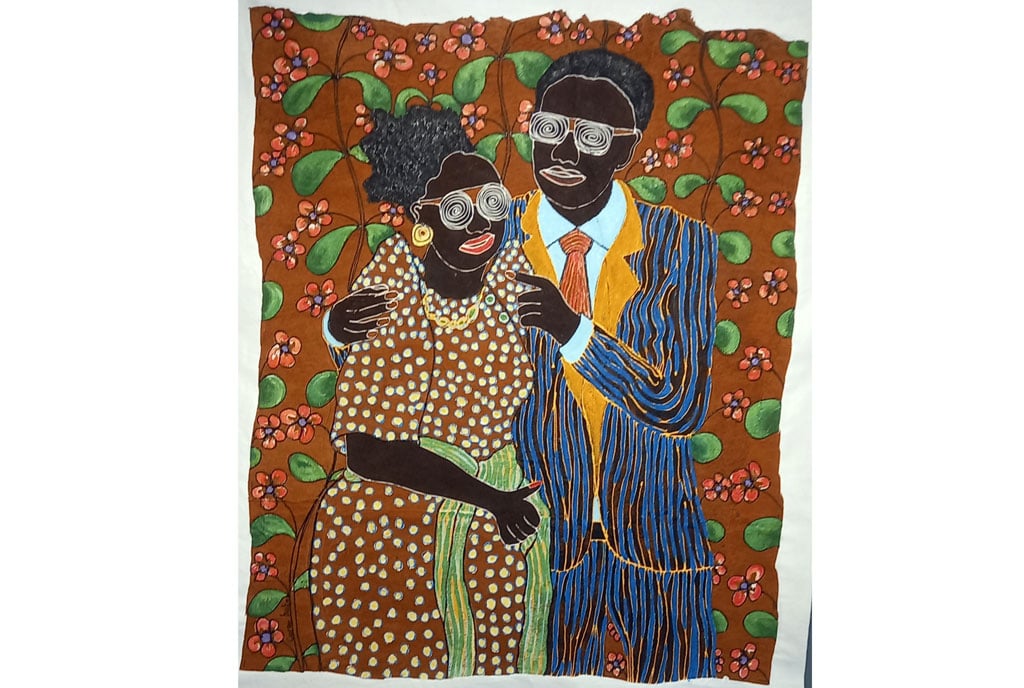Female artists tackle femininity in expo

Canary by Mona Taha. PHOTO/BAMUTURAKI MUSINGUZI
What you need to know:
- In a group exhibition that opened on May 27 and will run its course on August 12 at the Afriart Gallery, 10 female artists from eastern and southern Africa showcase their pieces, writes Bamuturaki Musinguzi.
At the Shapes of Water exhibition showcasing the works of 10 female artists from eastern and southern Africa in Kampala, one piece particularly lights up the Afriart Gallery.
Digitally manipulated, Blessed is the Spectrum is the handiwork of Charity Atukunda. It is intended to be seen in black and white – both literally and metaphorically. There are, however, lots of grey areas or nuances around a woman sporting a gomesi and braided hair having a smoke.
Atukunda says her work draws attention to a set of complicated questions: “What makes a respectable Ugandan woman? Who gets to decide what behaviour is considered appropriate? Do these behaviours and actions dictate how much you belong to your culture or on the periphery?”
She adds: “Through this work, I aim to speak on my individual experience of being a Ugandan woman and how it’s intertwined with the greater reality of how the more liberated and free-thinking a Ugandan woman becomes, the harder it becomes for their culture to accept them. This art piece asserts the right for women of all ideological leanings to exist in their traditional cultural spaces by portraying women in traditional clothing doing appropriate things.”
The group exhibition at the Afriart Gallery opened on May 27 and will run its course on August 12. On display are pieces by Amani Azhari (Sudan), Naseeba Bagalaaliwo (Uganda), Nelsa Guambe (Mozambique), April Kamunde (Kenya), Maliza Kiasuwa (DRC), Charlene Komuntale (Uganda), Kitso Lynn Lelliott (South Africa), Sungi Mlengeya (Tanzania), and Mona Taha (Uganda).
Shapes of Water draws inspiration from Rachel Bari’s poem titled Water Woman. The exhibition is curated by Lara Buchmann.
“In this exhibition, some of the physical, cultural, and political characteristics and implications of the element water may act as a metaphor or ‘lens’ through which to think about expressions of femininity in the artists’ work,” Buchmann tells Monitor, adding, “She is fluid. Femininity is fluid, so this exhibition suggests.
Femininity changes its shape as it pleases, disregarding the many voices trying to contain it in an eight-shaped vessel. She might turn into ice, breaking the vessel into pieces. She might rise from the vessel as a cloud and rain down on more fertile ground elsewhere.”
Other works
Sungi’s painting titled Lala (Swahili for sleep) depicts a woman lying down with her eyes closed. It is a solo project from 2020.
“Exhaustion, especially for women, has been normalised. Those who have day jobs, perform domestic chores and are still primary caretakers at home, are celebrated as superwomen, but should this be something to always celebrate?” she rhetorically asks.
Elsewhere, Azhari’s two artworks—It’s not Enough 1 and It’s not Enough 10—show the same female face in different appearances. The Sudanese artist says she “often paint[s] my facial features and put[s] them into the personality I am showing.”
The use of a single face on different personalities, she adds, “invite[s] the viewer to focus on what the characters feel and not on who they are.”

Blessed is the spectrum by Charity Atukunda. PHOTO/BAMUTURAKI MUSINGUZI
Bagalaaliwo, meantime has an animated short film titled Still from Scalp Deep. It focuses on why women cut hair, with Bagalaaliwo holding that the complex practice of short hair emanates from Christian missionaries, whose mission schools pushed for this look allegedly on account of black hair being ungodly.
“I believe Scalp Deep is an important and unique idea, which hasn’t been explored yet in Ugandan film, which can encourage conversations with young women about identity and being judged by something as impermanent as our hair,” Bagalaaliwo says, adding that the missionaries believed short hair made women look “less desirable.”
Pandemic influence
Guambe’s works—Homage to the Sailor I, and Homage to the Sailor II— are part of a larger body of work created after the deadly cyclone Dineo hit Inhambane and its surrounding coastal areas in Mozambique. After visiting her home village, Chicuque, Guambe found partly destroyed sails littering the village. Many fishermen lost their boats to Dineo. Guambe decided to collect these sails and use them as canvases for her paintings.
“I saw it as a way of giving a new life to the sails,” she says, adding, “The fact that one could reuse that material after such a loss seemed important to me.”
She depicts “a series of self-portraits of me and my sister” on the sails, reasoning that this was inspired by the loneliness birthed by the early stages of the coronavirus pandemic.
“As a young woman, one goes through these processes where you have to renew yourself - just like the sails I collected,” Guambe says.
Kamunde’s Sundays Are Not Rest Days I, and Sundays Are Not Rest Days II explore meanings of rest and the pursuit of it from both personal and feminist angles.
“I explore what it looks like to choose self, to take up space, to slow down and unburden oneself in today’s demanding world,” she says of her pandemic-inspired body of work.
The Dera (a long Somali dress), features prominently in the series. The dress is usually designed to fit loosely, giving ample room for aeration and movement. In Nairobi, Kenya, it is popular, especially as loungewear. To Kamunde, the Dera serves as a “Do Not Disturb” sign for the women who wear it, signalling “me time” and the reclamation of their energy.
Femininity
Kiasuwa’s Eco-target II and Eco-target III are made out of recycled everyday materials like luffa, wool, polyethylene cord, plastic tube, and threads.
“I mainly transform everyday items by combining reductive methods of shredding and twisting with constructive processes of tying, weaving, stitching and dyeing,” she says of the stimulating and eclectic elements used to celebrate Africa’s mystic power of nature, adding, “I use threads, recycled rubber, wool, and heterogeneous objects recovered, assembled, and wrapped in ropes and cords.”
Taha has two paintings—Leap, Diptych and Canary. She also has a poem titled Dawn. Leap, Diptych is a double-faced artwork of women holding a cloth and leaping in the air. Canary shows two women whose bodies are intertwined with maps of Africa on the left and right hands.
Komuntale’s digital paintings Liberation Dress and Free Dress show different women with their heads covered with open paper boxes with the word “Not Fragile” in colour red. The former toasts to women being “an unrelenting people whose benevolence, vulnerability, and beauty do not need validation” and the latter is “a reflection on the world’s skewed perspective of femininity.”
Lelliott has a video installation—Still from By and by some trace remains—in which she engages the vestiges of stories that do not get told, that get hidden or written out in the processes of narrativising and constructing canonic ‘official’ narratives.




